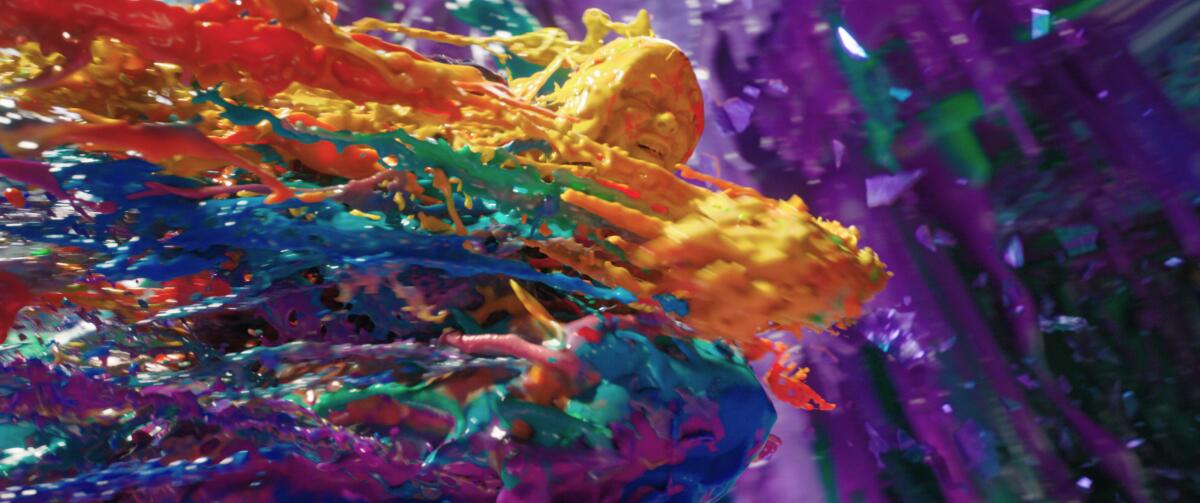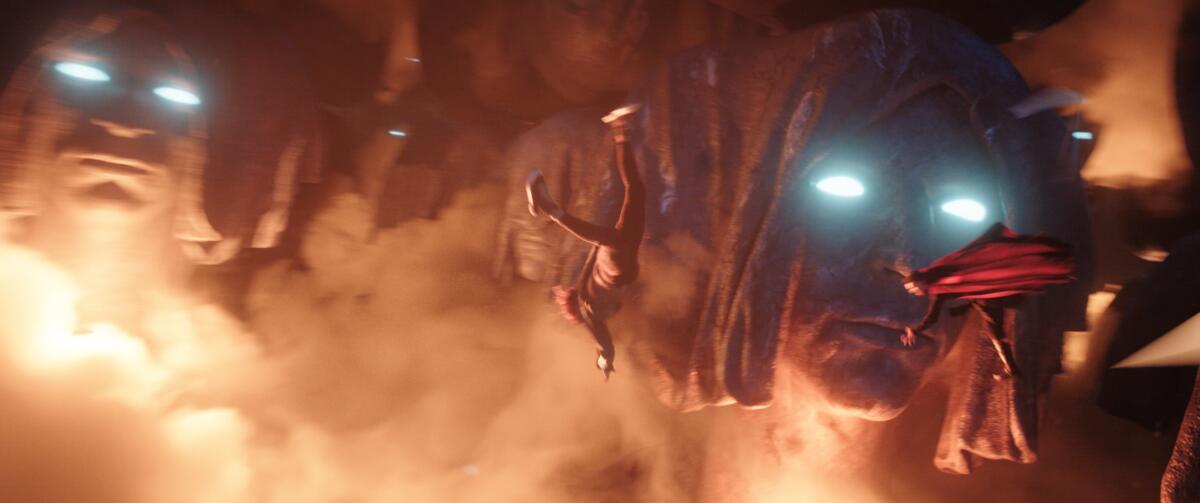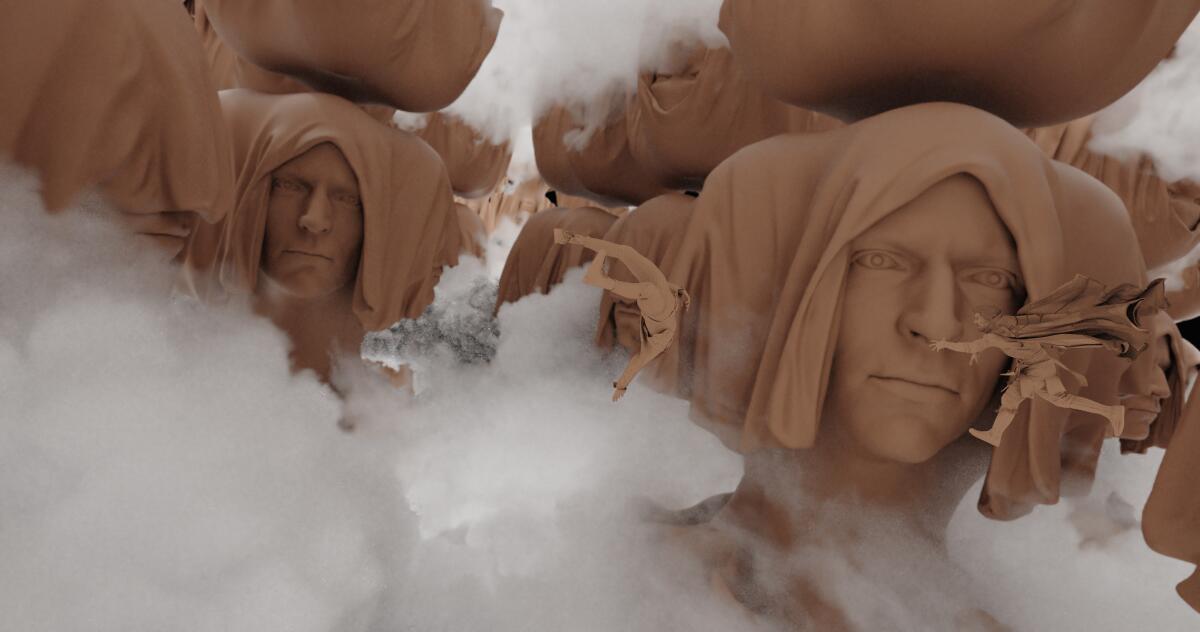How visual effects bring new dimension to Sam Raimi’s ‘Doctor Strange’

- Share via
The last time we saw Doctor Strange (Benedict Cumberbatch) in the Marvel Cinematic Universe, he was making the world forget Peter Parker (Tom Holland) was the friendly neighborhood Spider-Man in “No Way Home.” Now, in Sam Raimi’s “Doctor Strange in the Multiverse of Madness,” Strange returns for a second solo act following a six-year hiatus where fans first learned about the existence of parallel universes.
The sequel’s title speaks to the unraveling story line that has Strange protecting newcomer America Chavez (Xochitl Gomez), a teen with the ability to open star-shaped doorways to other dimensions, from an enemy trying to steal her powers. Visually, the familiar vibrancy and sheen of the MCU gloss the screen, but “The Evil Dead” auteur puts his own twist on the Michael Waldron screenplay, blending elements of intense horror with a dark tapestry of colors and a looming score from Danny Elfman.
Production visual effects supervisor Janek Sirrs (“Iron Man 2,” “The Avengers”) looked to a dozen VFX vendors to pull off the suspenseful adventure that whisks audiences deeper into the multiverse.
The demanding set pieces for visual effects included the film’s opening “dream” sequence that has Doctor Strange and America running from a demon through the Temple of Vishanti, a vivid, cloud-laced world that feels like a blend of Salvador Dalí and David LaChapelle: bright and photorealistic. Another is a valorous action sequence between Strange and Gargantos, an octopus-like monster ripped from the comic book pages, in the streets of New York where the beast wreaks havoc on the city in its attempt to capture America. VFX also opened a wider door into the Kamar-Taj, the Mystic Arts training grounds and home to Strange’s fan-favorite ally, the Sorcerer Supreme (Benedict Wong), before it burns to the ground in a fiery rage by one very incensed antagonist.
But the crème de la crème is a complex series of shots that has Strange and America traveling through myriad otherworldly dimensions in order to escape their enemy. It’s an eye-opening sequence that goes by quickly, but the meticulous level of detail involved got underway as far back as 2019
stemming from a single line in the script that said “… then they go into a portal ride.”


Sirrs tapped Framestore to create the moment, which was overseen daily by VFX supervisor Alexis Wajsbrot. The team sought to bring visually fresh aesthetics to the world of Doctor Strange, something more organic that felt unlike the first film. “The idea from Sam was that each dimension needed to be a big statement, because we are only going to stay in them for a few seconds,” notes Wajsbort. “Each world needed to be a world we can very clearly identify.”
Brainstorming sessions and previs mock-ups carved paths for the settings, but it was an early note from producer Kevin Feige that helped them to fine tune the concept. “He came up with the idea that it should be the same environment that switches. So we took the same New York street and changed it from world to world,” says Wajsbort. More than 20 original environments were conjured during the roughly 40-second sequence, including a prehistoric dimension complete with a roaming dinosaur, a comic book dimension, a world that transforms the characters into smears of paint and a block dimension that morphs their skin into tiny squares.

The kinetic scene ramps up as a fast-moving dynamic free-fall where Strange is trying to grab hold of an unconscious America before visually slowing down. “As soon as America wakes up, we wanted to switch the hero role, since it is the very first time Strange is in this, but America had done it multiple times. There’s a point where we wanted her to drive and Strange would be the scared guy,” says Wajsbort. “You can see it when she reaches for his neckline and leads him away with her arm and they leap into exiting the ride.”
Visual effects also needed to generate digital doubles of the actors to create the scene. Clothes, hair and skin were all simulated to match the lighting of the environments while animators used reference shots of facial expressions to build the emotion. Making the action visceral rested upon the small details of the universes — something the team continued to perfect up to three weeks before the movie release. “It’s very easy to make the worlds very lifeless, but once we started to add different things like giant bees, fish, cows … it added more life to them,” Wajsbort says.
More to Read
From the Oscars to the Emmys.
Get the Envelope newsletter for exclusive awards season coverage, behind-the-scenes stories from the Envelope podcast and columnist Glenn Whipp’s must-read analysis.
You may occasionally receive promotional content from the Los Angeles Times.








